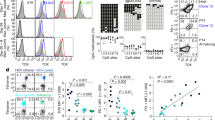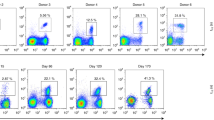Abstract
Mutations in viral genomes that affect T-cell–receptor recognition by CD8+ cytotoxic T lymphocytes have been shown to allow viral evasion from immune surveillance during persistent viral infections. Although CD4+ T-helper cells are crucially involved in the maintenance of effective cytotoxic T-lymphocyte and neutralizing-antibody responses, their role in viral clearance and therefore in imposing similar selective pressures on the virus is unclear. We show here that transgenic virus-specific CD4+ Tcells, transferred into mice persistently infected with lymphocytic choriomeningitis virus, select for T-helper epitope mutant viruses that are not recognized. Together with the observed antigenic variation of the same T-helper epitope during polyclonal CD4+ T-cell responses in infected pore-forming protein-deficient C57BL/6 mice, this finding indicates that viral escape from CD4+ T lymphocytes is a possible mechanism of virus persistence.
This is a preview of subscription content, access via your institution
Access options
Subscribe to this journal
Receive 12 print issues and online access
$209.00 per year
only $17.42 per issue
Buy this article
- Purchase on Springer Link
- Instant access to full article PDF
Prices may be subject to local taxes which are calculated during checkout





Similar content being viewed by others
References
McMichael, A. T cell responses and viral escape. Cell 93, 673–676 (1998).
Tortorella, D., Gewurz, B.E., Furman, M.H., Schust, D.J. & Ploegh, H.L. Viral subversion of the immune system. Annu. Rev. Immunol. 18, 861–926 (2000).
Domingo, E. & Holland, J.J. RNA virus mutations and fitness for survival. Annu. Rev. Microbiol. 51, 151–178 (1997).
Ciurea, A. et al. Viral persistence in vivo through selection of neutralizing-antibody-escape variants. Proc. Natl. Acad. Sci. USA 97, 2749–2754 (2000).
Parren, P.W.H.I., Moore, J.P., Burton, D.R. & Sattentau, Q.J. The neutralizing-antibody response to HIV-1: viral evasion and escape from humoral immunity. AIDS 13, S137–S162 (1999).
Pircher, H. et al. Viral escape by selection of cytotoxic T cell-resistant virus variants in vivo. Nature 346, 629–633 (1990).
Borrow, P. & Shaw, G.M. Cytotoxic T-lymphocyte escape viral variants: how important are they in viral evasion of immune clearance in vivo. Immunol. Rev. 164, 37–51 (1998).
Sette, A. et al. Antigen analogs/MHC complexes as specific T cell receptor antagonists. Annu. Rev. Immunol 12, 413–431 (1994).
Sloan-Lancaster, J. & Allen, P.M. Altered peptide ligand-induced partial T cell activation: molecular mechanisms and role in T cell biology. Annu. Rev. Immunol 14, 1–27 (1996).
Klenerman, P. et al. Cytotoxic T-cell activity antagonized by naturally occurring HIV-1 Gag variants. Nature 369, 403–407 (1994).
Bertoletti, A. et al. Natural variants of cytotoxic epitopes are T-cell receptor antagonists for anti-viral cytotoxic T cells. Nature 369, 407–410 (1994).
Kalams, S.A. & Walker, B.D. The critical need for CD4 help in maintaining effective cytotoxic T lymphocyte responses. J. Exp. Med. 188, 2199–2204 (1998).
Borrow, P. & Oldstone, M.B.A. Lymphocytic choriomeningitis virus. in Viral Pathogenesis . (ed. Nathanson, N.) 593–627 (Lippincott-Raven, Philadelphia, 1997).
Oxenius, A., Bachmann, M.F., Zinkernagel, R.M. & Hengartner, H. Virus-specific MHC class II-restricted TCR-transgenic mice: Effects on humoral and cellular immune responses after viral infection. Eur. J. Immunol. 28, 390–400 (1998).
Ciurea, A. et al. Impairment of CD4+ T cell responses during chronic virus infection prevents neutralizing-antibody responses against virus escape mutants. J. Exp. Med. 193, 297–305 (2001).
Kagi, D. et al. Cytotoxicity mediated by T cells and natural killer cells is greatly impaired in perforin-deficient mice. Nature 369, 31–37 (1994).
Oxenius, A., Zinkernagel, R.M. & Hengartner, H. Comparison of activation versus induction of unresponsiveness of virus-specific CD4+ and CD8+ T cells upon acute versus persistent viral infection. Immunity 9, 449–457 (1998).
Hotchin, J. E. & Cinits, M. Lymphocytic choriomeningitis infection of mice as a model for the study of latent virus infection. Can. J. Microbiol. 4, 149–163 (1958).
De Magistris, M. T. et al. Antigen analog-major histocompatibility complexes act as antagonists of the T cell receptor. Cell 68, 625–634 (1992).
Muller, D. et al. LCMV-specific, class II-restricted cytotoxic T cells in beta 2- microglobulin-deficient mice. Science 255, 1576–1578 (1992).
Zajac, A. J., Quinn, D.G., Cohen, P.L. & Frelinger, J.A. Fas-dependent CD4+ cytotoxic T-cell-mediated pathogenesis during virus infection. Proc. Natl. Acad. Sci. USA 93, 14730–14735 (1996).
Guidotti, L. G. & Chisari, F.V. Noncytolytic control of viral infections by the innate and adaptive immune response. Annu. Rev. Immunol. 19, 65–91 (2001).
Ossendorp, F. et al. A single residue exchange within a viral CTL epitope alters proteasome-mediated degradation resulting in lack of antigen presentation. Immunity 5, 115–124 (1996).
de Campos-Lima, P. O. et al. HLA-A11 epitope loss isolates of Epstein-Barr virus from a highly A11+ population. Science 260, 98–100 (1993).
Reid, S.W. et al. Antagonist HIV-1 Gag peptides induce structural changes in HLA B8. J. Exp. Med. 184, 2279–2286 (1996).
Rammensee, H.-G., Friede, T. & Stefanovic, S. MHC ligands and peptide motifs: first listing. Immunogenetics 41, 178–228 (1995).
Jameson, S.C., Carbone, F.R. & Bevan, M.J. Clone-specific T cell receptor antagonists of major histocompatibility complex class I-restricted cytotoxic T cells. J. Exp. Med. 177, 1541–1550 (1993).
Raulet, D.H. MHC class I-deficient mice. Adv. Immunol. 55, 381–421 (1994).
Lehmann-Grube, F., Lohler, J., Utermöhlen, O. & Gegin, C. Antiviral immune responses of lymphocytic choriomeningitis virus-infected mice lacking CD8+ T lymphocytes because of disruption of the β2-microglobulin gene. J. Virol. 67, 332–339 (1993).
Perarnau, B. et al. Single H2Kb, H2Db and double H2KbDb knockout mice: peripheral CD8+ T cell repertoire and anti-lymphocytic choriomeningitis virus cytolytic responses. Eur. J. Immunol. 29, 1243–1252 (1999).
Guidotti, L. G. et al. Viral clearance without destruction of infected cells during acute HBV infection. Science 284, 825–829 (1999).
Guidotti, L. G. et al. Noncytopathic clearance of lymphocytic choriomeningitis virus from the hepatocyte. J. Exp. Med. 189, 1555–1564 (1999).
Moskophidis, D. et al. Role of virus and host variables in virus persistence or immunopathological disease caused by a non-cytolytic virus. J. Gen. Virol. 76, 381–391 (1995).
Moskophidis, D., Lechner, F., Pircher, H. & Zinkernagel, R.M. Virus persistence in acutely infected immunocompetent mice by exhaustion of antiviral cytotoxic effector T cells. Nature 362, 758–761 (1993).
Gallimore, A. et al. Induction and exhaustion of lymphocytic choriomeningitis virus- specific cytotoxic T lymphocytes visualized using soluble tetrameric major histocompatibility complex class I-peptide complexes. J. Exp. Med. 187, 1383–1393 (1998).
Zajac, A.J. et al. Viral immune evasion due to persistence of activated T cells without effector function. J. Exp. Med. 188, 2205–2213 (1998).
Varga, S.M. & Welsh, R.M. Detection of a high frequency of virus-specific CD4+ T cells during acute infection with lymphocytic choriomeningitis virus. J. Immunol. 161, 3215–3218 (1998).
Kamperschroer, C. & Quinn, D.G. Quantification of epitope-specific MHC class-II-restricted T cells following lymphocytic choriomeningitis virus infection. Cell. Immunol. 193, 134–146 (1999).
Moskophidis, D. & Zinkernagel, R.M. Immunobiology of cytotoxic T-cell escape mutants of lymphocytic choriomeningitis virus. J. Virol. 69, 2187–2193 (1995).
Siliciano, R.F. et al. Analysis of host-virus interactions in AIDS with anti-gp120 T cell clones: effect of HIV sequence variation and a mechanism for CD4+ cell depletion. Cell 54, 561–575 (1988).
Harcourt, G.C., Garrard, S., Davenport, M.P., Edwards, A. & Phillips, R.E. HIV-1 variation diminishes CD4 T lymphocyte recognition. J. Exp. Med. 188, 1785–1793 (1998).
Wang, H. & Eckels, D.D. Mutations in immunodominant T cell epitopes derived from the nonstructural 3 protein of hepatitis C virus have the potential for generating escape variants that may have important consequences for T cell recognition. J. Immunol. 162, 4177–4183 (1999).
Battegay, M. et al. Quantification of lymphocytic choriomeningitis virus with an immunological focus assay in 24- or 96-well plates. J. Virol. Methods 33, 191–198 (1991).
Oxenius, A. et al. CD40-CD40 ligand interactions are critical in T-B cooperation but not for other anti-viral CD4+ T cell functions. J. Exp. Med. 183, 2209–2218 (1996).
Zinkernagel, R.M., Leist, T., Hengartner, H. & Althage, A. Susceptibility to lymphocytic choriomeningitis virus isolates correlates directly with early and high cytotoxic T cell activity, as well as with footpad swelling reaction, and all three are regulated by H-2D. J. Exp. Med. 162, 2125–2141 (1985).
Acknowledgements
We appreciate the help in the generation of DNA sequence data of D. Zimmermann and his group. This work was supported by the Swiss National Science Foundation grants 31.50900.97 and 31.50884.97, and the Kanton of Zurich.
Author information
Authors and Affiliations
Corresponding author
Rights and permissions
About this article
Cite this article
Ciurea, A., Hunziker, L., Martinic, M. et al. CD4+ T-cell–epitope escape mutant virus selected in vivo. Nat Med 7, 795–800 (2001). https://doi.org/10.1038/89915
Received:
Accepted:
Issue Date:
DOI: https://doi.org/10.1038/89915
This article is cited by
-
Evidence of CD4+ T cell-mediated immune pressure on the Hepatitis C virus genome
Scientific Reports (2018)
-
CD8+ and CD4+ cytotoxic T cell escape mutations precede breakthrough SIVmac239 viremia in an elite controller
Retrovirology (2012)
-
T cell recognition of weak ligands: roles of signaling, receptor number, and affinity
Immunologic Research (2011)
-
CD4+ T cells: The great escape
Nature Medicine (2001)



